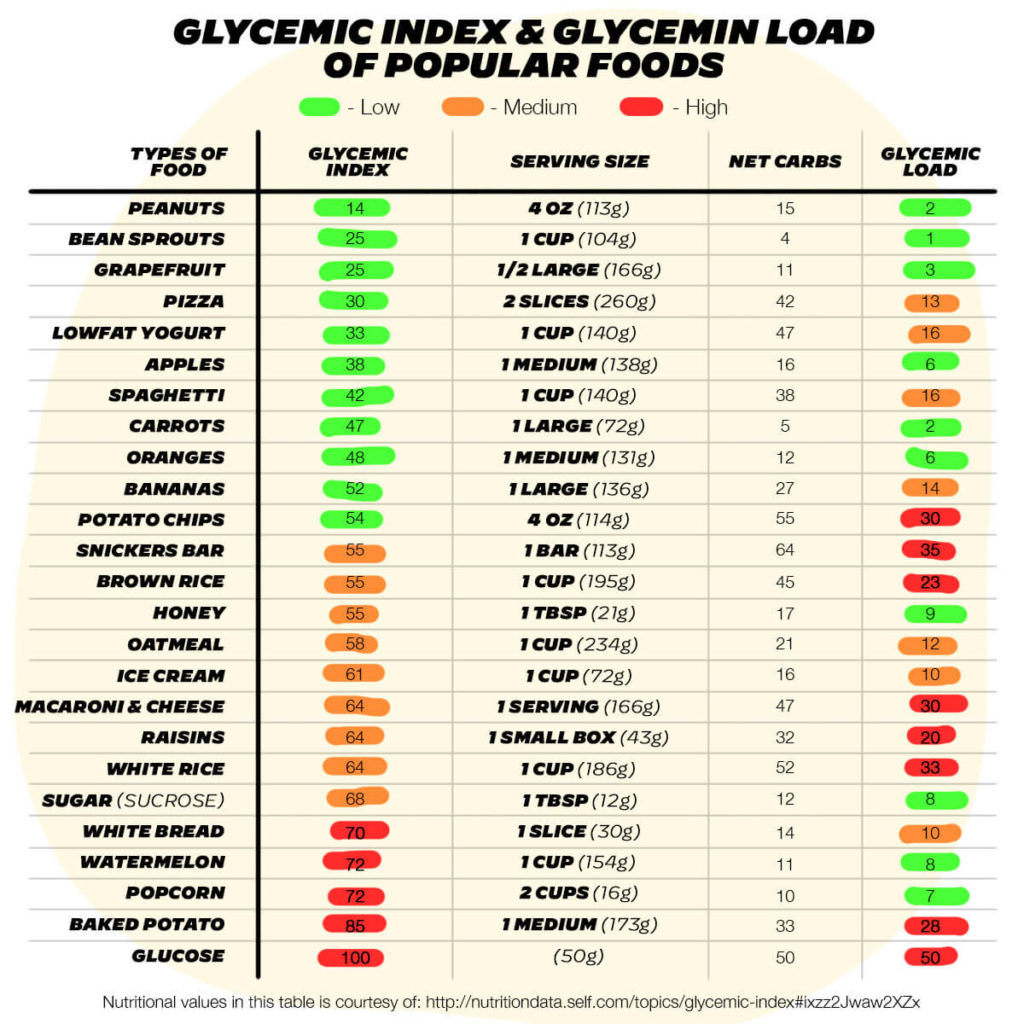What is the Glycemic Index?
If you’ve ever been curious about the impact of the foods you eat on your blood sugar, the answer may lie in the glycemic index. The glycemic index (GI) refers to a grading system for foods containing carbohydrates. It indicates how quickly each food affects your blood sugar (glucose) level when it is consumed on its own. Not all carbohydrates are created equal. The glycemic index (GI) ranks carbohydrates in a food on a scale from 0 to 100, according to their blood sugar-raising potential. It was formulated in the 1980s by a Canadian professor, Dr. David Jenkins.
Foods with a high GI are rapidly digested, absorbed and metabolised, with marked fluctuations in glucose levels. Low GI foods produce smaller fluctuations in your blood glucose and insulin levels and work towards ensuring long-term health by reducing the risk of type 2 diabetes and heart disease. It is also considered key for maintaining weight loss. A 2014 review also showed that low-glycemic-index diets may even offer anti-inflammatory benefits.
High GI foods that are broken down quickly by the body include sugar, sugary foods, sugary soft drinks, white bread, potatoes and white rice among others. Low GI foods include some fruits and vegetables, pulses, wholegrain foods and oats among others. A comprehensive list of foods with their GIs is available here.
A number of factors can determine the GI measure of a food – the type of sugar it carries, the structure of the starch, how refined the carb is, the nutrient composition, the cooking method and the ripeness of the food.
How does GI help?
According to the Harvard T.H. Chan School of Public Health, foods with a rating of 55 or less are low-glycemic foods and foods rated 70-100 are considered high-glycemic foods. Medium-level foods have a glycemic index of 56-69.
To understand GI one needs to understand the relationship between carbohydrates and blood sugar or carbohydrate metabolism. When you eat something that holds carbohydrates, the digestible carbs are broken down into sugar. After eating, blood sugar levels rise. The pancreas produces the hormone, insulin. It helps the cells to absorb blood sugar for energy and storage. With this absorption, glucose levels in the bloodstream begin to decline. The pancreas then produces glucagon, a hormone that promotes breakdown of glycogen to glucose (glycogenolysis), promotes glucose synthesis (gluconeogenesis), inhibits glycogen formation (glycogenesis), and thus mobilizes export of glucose into the circulation.
The cells of individuals who have insulin resistance don’t respond well to insulin, barring the glucose from entering these cells with ease. The glucose level in their blood rises over time even as their body produces more insulin as the cells defiantly resist insulin.
Research suggests that replacing high-glycemic-index carbohydrates with a low-glycemic-index variant improves glycemic control. High intake of carbohydrates with a high glycemic index yielded greater insulin resistance than did the intake of low-glycemic-index carbohydrates.
Studies have shown that the low GI diet may result in weight loss, reduce blood sugar levels, and lower the risk of heart disease and type 2 diabetes. Diets higher in GI have also been correlated with an increased risk of type 2 diabetes.
Carbohydrates were earlier perceived in terms of the binary of simple carbohydrates (with a simple chemical structure composed of only one sugar – monosaccharides, or two sugars – disaccharides and complex carbohydrates (with complex chemical structures of three or more sugars linked together known as oligosaccharides and polysaccharides). Simple carbohydrates are immediately utilised by the body for energy, spiking blood sugar levels. Many complex carbohydrate foods are repositories of fiber, vitamins and minerals, and they take longer to digest. These complex carbs don’t have an instant impact on blood sugar, making it rise gradually. But complex carbs like white bread make for starchy food with less fiber. The complex and simple carbohydrate classification does not explain the effect of carbohydrates on blood sugar and chronic diseases. The glycemic index is regarded as a better way to categorise carbohydrates to clarify the impact of varied carbohydrate-rich foods on blood glucose.

Glycemic load
But the GI of food alone is not a good enough indicator of wellbeing. What it fails to detect is how and how much digestible carbohydrate (which essentially excludes fibre) it delivers. This ends up overrepresenting the glucose spike of certain food and underrepresenting the glucose spike of others. For example, watermelon has a GI value of 80, which would put it in the category of food to avoid. But a serving of watermelon has very little digestible carbohydrates, so it does not cause a sugar spike.
This is where the glycemic load (GL) comes in, which is a more accurate way of gauging how much a food will affect your blood sugar levels. The GL takes into account the amount of carbohydrate in a product and its GI. A food’s GL levels are calculated by multiplying its glycemic index by the amount of carbohydrate it contains. In general, a glycemic load of 20 or more is high, 11 to 19 is medium, and 10 or under is low.
Although GL makes up for the caveat that GI presents, it is still not the complete answer.
What is glycemic variability?
Some people also consider the concept of glycemic variability (GV), which refers to swings in blood glucose levels that occur throughout the day. Although a certain degree of variability naturally occurs in people with normal glucose tolerance, GV is usually increased in people with diabetes and weakened blood glucose regulation.
The American Diabetes Association says that the total amount of carbohydrate in a food is a stronger predictor of what will happen to blood sugar than the food’s GI. Some dietitians also feel that focusing on the glycemic index and load adds an unneeded layer of complexity to choosing what to eat. Additionally, it is always advisable to consider the nutritional content of a food as a whole, since it provides information on how much fat, sugar, sodium, calcium and other nutrients the food contains. This provides a holistic picture of the food from which more educated choices for the right diet can be made.
Conclusion
Glycemic Index refers to a relative measure of the incremental glucose response per gram of carbohydrate. It has emerged as a more reliable parameter of classification of carbohydrates than that of complex and simple carbs, bearing important implications for the food industry. Foods with high GI are associated with significant fluctuations in blood glucose whilst low GI foods are markers of smaller changes in glucose levels. But the GI does not tell the entire story about the carbohydrate content of food. Its ranking system is criticised for not reflecting the overall healthfulness of the food. Glycemic load and glycemic variability are relevant factors in this discussion. Considering the nutritional content of a food as a whole is recommended.
References
- Atkinson FS, Foster-Powell K, Brand-Miller JC. International tables of glycemic index and glycemic load values: 2008. Diabetes Care. 2008 Dec;31(12):2281-3. doi: 10.2337/dc08-1239. Epub 2008 Oct 3. PMID: 18835944; PMCID: PMC2584181.
- Brand-Miller J, Buyken AE. The Relationship between Glycemic Index and Health. Nutrients. 2020 Feb 19;12(2):536. doi: 10.3390/nu12020536. PMID: 32093020; PMCID: PMC7071350.
- Wolever TM. Effect of macronutrients on the glycemic index. Am J Clin Nutr. 2017 Aug;106(2):704-705. doi: 10.3945/ajcn.117.158055. PMID: 28765391; PMCID: PMC5525124.
- Parker A, Kim Y. The Effect of Low Glycemic Index and Glycemic Load Diets on Hepatic Fat Mass, Insulin Resistance, and Blood Lipid Panels in Individuals with Nonalcoholic Fatty Liver Disease. Metab Syndr Relat Disord. 2019 Oct;17(8):389-396. doi: 10.1089/met.2019.0038. Epub 2019 Jul 15. PMID: 31305201.








